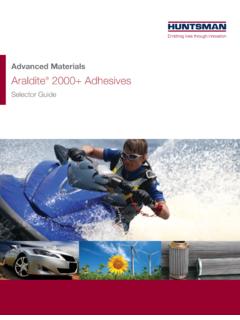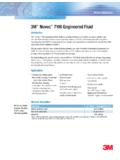Transcription of MONOMER-FREE ACRYLIC WITH EXTREMELY LOW …
1 AT THAT TIME, pmma came to replace vulcanised rubber dentures, which were often difficult to manufacture. The switch from rubber to plastic happened relatively smoothly due to the superior qualities of a pmma compared to a rubber spite of very rapid developments in the field of plastics, after more than 60 years the majority of dentures are still produced from materials based on the two-component system, consisting of methyl methacrylate MMA and pmma . In the meantime, many variants of these materials have been developed and processing techniques are getting faster all the time. In contrast to the last century when all pieces were still being pressed, moulding is now the standard.
2 Why then is there a need for new materials and/or techniques for the manufacture of dentures?AllergyDue to the continuous and more extensive use of foreign materials and the development of new dental materials, the number of cases of allergic reaction also appears to be increasing. Well-known allergens include residual monomer , peroxides and metals, however the number of undesired MONOMER-FREE ACRYLIC with EXTREMELY LOW SHRINKAGEThe low-allergen denturePlastics play a key role in dentistry today as the raw material in cements applied in restorative dentistry, the base material for dentures and in other applications.
3 Polymethyl methacrylate ( pmma ) has been the standard for this prosthetic application as far back as the 1950s. by Jip Kreijns, MA, is a dentistry consultant and practising dentist. He was editor of TandartsPraktijk between 1990 and to denture base materials is also increasing. This is to be explained in part by the additives plastics used to manufacture dentures often consist not only of pmma , but also of other added plastics and colouring agents. The leaching of colouring agents or denture cleansing liquids, and the release of residual monomer can cause allergic symptoms. This risk is highest immediately after a new denture has been fitted or following repair.
4 The production technique plays a vital role in the amount of residual monomer released. Cold polymerisates (mostly applied for repairs and rebasings) lose more residual monomer in the initial stages than hot polymerisates. The latter are primarily used for new 1 An allergic reaction to polymethyl methacrylate makes wearing an upper denture virtually 2 Working with monomer can cause a severe allergic reaction, resulting in unfitness for work. 12 BurningOne frequently occurring symptom reported by denture wearers, which is similar to an allergic reaction, is that of a burning sensation in the mouth or on the tongue.
5 These symptoms, similar to those of burning mouth syndrome (BMS), can make the wearing of a denture virtually impossible. It is estimated that around 1 to 5 percent of adults suffer from a painful or burning sensation of the oral mucosa. A key characteristic of BMS is that no underlying dental or medical cause of the symptoms can be demonstrated. During the day, the pain may vary in severity and can last for many years. This is a very common clinical complaint, in which anomalies are not usually observed in the mucosa. Around 70% of BMS patients suffer from taste disorders, also known as dysgeusia.
6 Patients generally complain of a bitter or metallic taste (or both) in the of the patients indicate that the symptoms of burning mouth syndrome have a huge impact on the quality of their lives. The cause is often related to bio-incompatible reactions to materials which can leak out of the denture and induce a local toxic or allergic reaction. Patients who are shown to have an allergic reaction following a proper dermatological examination will benefit from avoiding the allergen. These reasons alone give good grounds for seeking alternatives to methyl methacrylates as a base material for dentures as well as investigating other processing techniques for this of hazardous materialsMany other production techniques have been developed over the past 40 years in addition to pressing and/or moulding dentures from a MMA- pmma system: from light curing paste systems to microwave polymerisation, and from the closed injection technique to thermoplastic systems.
7 The latter techniques in particular offer a range of variants and options which however are not in common use. The flexible character and often poor appearance of the materials is one of the main reasons why these thermoplastic techniques have not gained any real popularity in Europe. As a result, development of the material and associated techniques has not proceeded, preventing any real breakthroughs for , there are many reasons why thermoplastic products are ideally suited to the world of dental mechanics. In the first place, these products are completely free of residual monomers, accelerator systems and stabilisers.
8 Secondly, thermoplastic products are always homogenous in composition and thirdly they respond consistently during processing. Last, but not least, is the fact that thermoplastic materials have no adverse impact on the technician or the dental lab due to the absence of hazardous of thermoplasticsThermoplastics are polymers which can be made reversibly liquid by raising the temperature. They are placed in a mould when in a molten state and later fixed after the mould has cooled down. A range of thermoplastic materials are used in dental mechanics. Alongside polymethyl methacrylates, which can also be effectively processed thermoplastically, nylons are the best known of these.
9 The chemical name for these materials is polyamides, often abbreviated to used, although less familiar, are acetal and polystyrene. Acetal is a polyoxymethylene or POM. Polystyrene is abbreviated to SAN since the full chemical name is styrene acrylonitrile. Their physical properties and diversity make each of these materials unique in terms of processing and based on POMs are characterised by high breaking strength, wear resistance and flexibility. However, these thermoplastics lack the natural translucency typical in pmma . Polycarbonates, on the other hand, are translucent and have sufficient flexibility and breaking strength, but are very susceptible to wear and tear.
10 For this reason, polycarbonates are suitable for temporary work but not for permanent dentures. pmma , as a thermoplastic material, appears to be the ideal product, but the high processing temperature and viscosity mean it is not easy to most commonly used thermoplastic materials are based on PA. These polyamides are primarily characterised by their flexibility, toughness, high breaking strength, Fig. 3 Broken dentures are usually repaired with cold-polymerising resin. These cold polymerisates lose a relatively large amount of residual monomer in the initial 4 Colouring agents are added to the pmma denture.




